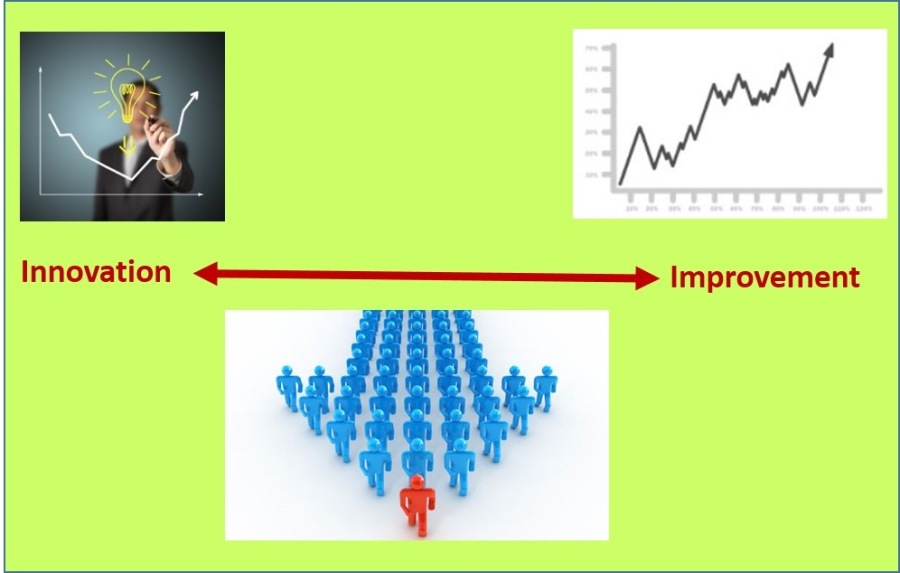Tips for Leading Innovation and Continuous Improvement

“Leadership!” “Those at the top must lead the parade!” “Can’t do anything without the leaders.”
Ask anyone, what is the most critical success factor in a company’s drive to be innovative or to continuously improve? “Leadership support!” Without hesitation, these are the kind of answers you get.
True, of course, but not particularly helpful.
Senior executives are just people. They are people who have risen to a level where they inspire as much fear as respect. People carefully craft what they say around them. As a result, senior executives rarely get leadership how to manuals or even helpful feedback. So this article is intended to give some helpful tips. If you are a senior executive, feel free to use what is helpful. If you know a senior executive, feel free to share what you think will be helpful to them. (Remembering that help that isn’t asked for is often seen as interference. So photocopying the article and slipping a copy under their door in the dead of night is unlikely to be very effective.)
I have written elsewhere that innovation and improvement exist of a continuum. Both require a systematic process, which is followed rigorously. Both require divergent thinking techniques like brainstorming to come up with ideas and convergent thinking techniques like the prioritization criteria matrix to winnow those ideas down to decide which to implement. Innovation often has a longer time horizon (new products that will last five years.) Continuous improvement is often more immediate (reduce the cycle time of this process by 3 days this month.) Both methodologies have unique languages and require unique knowledge and skill development. Both require an innate understanding of the voice of the customer – the person for whom you are innovating or improving.
In companies that I have helped implement continuous improvement or innovation, most senior executives truly want to be supportive of the effort. Often they have put a person they trust in charge of the initiative. Sometimes that person is at too low a level, or has too many other things on her plate, but just as often this is a very dedicated and competent mid-level executive, who takes the job quite seriously.
Therein lies the first tip:
You can’t delegate change. No matter how dedicated and competent the person running continuous improvement or innovation is, you still have some responsibilities. If that person is really good, she will act as your coach in this, but that coaching relationship will be a lot easier if you initiate it.
Some other tips:
Focus, align on one methodology Continuous Improvement has a variety of “brands,” Lean” “Six Sigma,” “Process Improvement,” “Reengineering,” to name a few. Innovation has its own panoply of methodologies, “Human Centered Design,” “Rapid Results,” “Agile,” etc. I’ve come to believe that leaving the methodology to chance or choice is an advanced concept, a little like “spin” in tennis – “Alan, quit trying to cut the ball and concentrate on getting it over the net.”
Learn the language. Every methodology has its own unique language. The process is defined by the language and you will avoid the “Me talk pretty one day” trap if you learn it.
Learn the process by doing a project. It doesn’t have to be a big project; it could be but it doesn’t have to be. What is important is that you have some examples to talk about. Leading by example is the most powerful form of leadership. If you can’t think of anything, ask your assistant or your coach, but do at least one. The symbolism will be powerful.
Create the right metrics. Metrics drive behavior. So if you measure the number of projects you are likely to get a lot of projects, but no results. Good high level metrics for innovation, the revenue from new products or markets not in the portfolio 2 years ago. Improvement metrics are cost reductions or revenue increases from improvement projects. It is important that all metrics be audited (perhaps by finance) to avoid double counting. Reward results that actually drop to the bottom line. This will require some discipline, accounting for the effect of intervening variables (like economic bubbles or collapse) and tracking savings before you spend the money on something else.
Emphasize the delta. As I train in innovation and continuous improvement, I often tell participants that I can tell how successful a client will be in this initiative, by how the executives talk about the numbers. If the executive mentions one solitary number, 15% ROI, or $1.2 million in revenue, I’ve come to learn that it bodes ill for success. However, if that executive mentions that number in comparison to another number, 15% ROI this quarter u from 12% last quarter, or $1.2 million in sales compared to xyz competitor at $.75 million, that tends to show an interest in improved performance or the tracked value of innovation. These are comparative games; trends are important.
Connect business priorities to innovation or improvement projects. This is a leader’s job. What are we trying to get done strategically? What will require improvement from current performance? What will require brand new products, marketing approaches, or business models? Sponsor the improvement projects or innovation initiatives to get us there. I’ve seen far too many “move the supply closet” type projects waste valuable resources when strategic priorities languish.
Reward learning: No, I don’t mean the number of people trained. I mean what people are learning and sharing from projects. I’ve seen companies reward translation of improvement projects from one division to another. I’ve seen companies reward “the idea that looked the best on paper, but was the most miserable failure.” Find a way of rewarding real learning because that not making the same mistakes someone else made is a sign of higher intelligence. This is a practice makes perfect game, but it only accelerates if you share the learning.
Be visible: Kick-off or close training sessions, attend lunch-and-learn sessions, run project sharing sessions, conduct the occasional town hall on the subject. Carry the Innovation and/or improvement flag.
Look for symbolic acts that communicate that this is important: Who gets hired and promoted? Who has access to you? How do you react when a big innovation or improvement project fails? (“OK, so what did we learn from this?”) Sharing the credit for your project. Promoting the results of a small project that made a big difference to your peers and even to shareholders. A leader can’t do it all, shouldn’t do it all, but they can invest their passion wisely.
View your leadership as a process. How are you innovating? Improving? Learning? Performing? (In that order.)
“Leadership!” “Those at the top must lead the parade!” “Can’t do anything without the leaders.”
The pressure must be crushing. I often tell executives “Cut yourself a little slack. Join the parade. You can still lead from the middle. Be open about what you are learning.”
I have to talk like that -36 plus years of doing this and I learn new stuff every day. Sometimes, I feel very stupid, when I am confronted with ways I must innovate or improve, I cover it by self-describing as a “late adopter.” “I’m slow, but I’m learning. I’m a late adopter not a never adopter.”
"
Articles from Alan Culler
View blog
David Frye's impression of Richard Nixon · When I was a college market speakers agent, I sold to you ...

“‘I need your help,’ the blond whispered in my ear as she took me by the arm and started fast-walkin ...

I had been an aspiring actor, waiting tables and diving a taxi for a couple of years. Then I decided ...
You may be interested in these jobs
-

Associate Director Director Product Development
10 hours ago
Avalyn Pharma Inc Cambridge, United StatesBenefits: · 401(k) matching · Company parties · Competitive salary · Dental insurance · Health insurance · Opportunity for advancement · Paid time off · Parental leave · Stock options plan · Vision insurance · Wellness resources · Associate Director / Director, Produc ...
-

Project Administrator
1 week ago
Kimley-Horn Alexandria, United States Paid WorkOverview · At Kimley-Horn, one of the nation's premier planning and design consultants, our professionals are experts in many disciplines yet share one passion: making our clients successful. Ranked as one of Fortune Magazine's "100 Best Companies to Work For," Kimley-Horn prides ...
-

Staff Software Engineer
5 days ago
VICTORY Austin, United StatesAbout the Staff Software Engineer position · We are looking for a Staff Software Engineer who will be a key member of the Engineering team. You will be architecting, implementing and maintaining the SaaS Platform and other software products. · You are good at collaboration. You ...
Comments